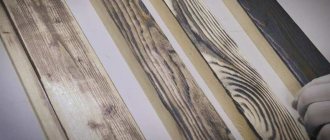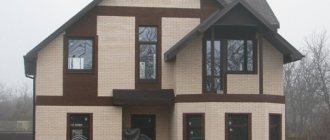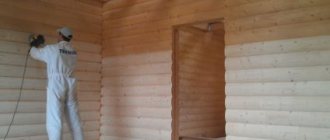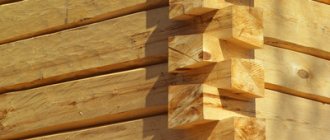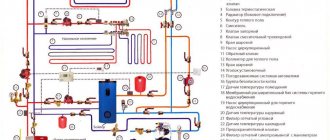Material storage.
Why did I start with nails? The point here is not only about savings, but also about the convenience of subsequent storage. Boards with protruding nails take up about 3 times more space. And when you have only 6 acres with an old garden and buildings on them, you quickly begin to understand that you need to save space.
The time spent on pulling out a nail and bending it is almost the same.
You need to be careful when storing material so that you don’t have to drag boards and logs from place to place several times. It is necessary to think through all further actions during construction in advance.
For example, if excavation work is planned, then it is better to move the boards away from the future foundation pit so that they do not interfere with the work. In addition, it is better to choose a higher place for stacks. Then they will not end up in a puddle after rain or from melted snow in the spring. It is also advisable to put opaque material under them to prevent grass from growing under them. For this purpose I used roofing felt, which I removed from the walls and roof.
In addition, I used an old greenhouse as temporary storage. Many of the windows in it were broken, so to prevent rain from dripping on the boards, I also covered it with roofing felt.
Sawdust, glass wool and safety precautions. After dismantling the interior decoration of the attic, I went down to the first floor. I would like to note once again that at the first stage I did not touch the racks in order to prevent collapse, but only tore off the sheathing.
Sawdust and small shavings mixed with lime were used as insulation in the ceiling of the first floor. Adding lime is a very old and reliable way to get rid of mice. In any case, I did not find any traces of these annoying rodents in the sawdust. But they lived comfortably in glass wool...
The sawdust turned out to be dry, so I also decided to save it “just in case” - I poured it into plastic bags and put it under the roof. In the future they may be useful for their intended purpose, and if not, they will be used as fertilizer.
Glass wool was installed under the first floor sheathing. This created an additional problem, since it was not safe to work with, and after so many years it fell apart in the hands, which created unnecessary difficulties.
To avoid itching later, I took precautions. First, I put on clothes made of thick fabric and fastened all the buttons. He put a special helmet on his head, and two pairs of gloves on his hands (first fabric, and rubber on top). It must be said that the glass wool often pierced this protection, and then I suffered, trying to pull out the brittle splinters.
Secondly, I put on goggles and a respirator.
And thirdly, so that the glass wool generates less dust during disassembly, I first sprayed it with water, and immediately placed the extracted pieces of insulation into 120-liter plastic bags. This, in my opinion, is the optimal size in terms of weight and volume. However, if the glass wool is very wet, then it is better to use 60 liter bags, making several holes at the bottom with a nail for water drainage.
Here it is appropriate to say a few more words about safety precautions. The work of demolishing old buildings is often not without injury.
For example, when dismantling the roof, I was standing below on the stairs, trying to tear off the gable cornice board. But I didn’t calculate my strength, it came off and fell on my head, unprotected even by my cap. It’s good that the rusty nail only tore the skin on my head and didn’t stick into my head. But I still had to get stitches at the emergency room. Therefore, I strongly advise everyone who is preparing for such work to follow safety precautions!
The main nuances of dismantling a wooden house
Dismantling a wooden structure involves the following sequence of processes: first, internal work is carried out, then the roof is dismantled, then the walls. If you are dismantling a house that is a frame structure, you should prepare for the fact that there will be an abundance of nails as fasteners. They should be pulled out from the sheathing boards with a nail puller. This manipulation will save the space occupied by the boards (their volume without nails is 3 times less than with them). In addition, the cladding will already be prepared for subsequent use in construction.
If the house is not completely dilapidated, there will definitely be materials in it that can either be used in the future or sold. Think about which building elements you will keep and which ones are best disposed of as unnecessary.
Another “surprise” in such structures can be insulation in the form of glass wool. As a rule, over time it becomes so rotten that it crumbles in the hands into small dust-like particles, so working with it without a respirator, thick clothing with sleeves and two pairs of gloves (fabric and rubber) is strictly prohibited. To make it easier to remove glass wool, you can moisten it with water and only then put it in plastic bags, which are first pierced in several places with a nail to remove moisture.
Dismantling a wooden floor set on nails has some special features. For example, if you plan to use the old flooring in the future, you will need to number the boards to ensure the exact order of installation.
Dismantling a wooden house yourself is quite difficult, but it is possible
Before dismantling the external walls, windows should be removed from them. Here it is necessary to follow a certain sequence, otherwise the glass may break. First you need to remove the sashes. This is done by hand or with a crowbar. Severely soured loops should be sawed with a grinder. Next, the box is dismantled: its dismantling will be much easier and faster if you initially cut the side posts in half. After this manipulation, the box is pulled out without extra effort using a hatchet or the same crowbar.
Preparing for house demolition
Of course, breaking is not building. But in order to properly demolish any structure, good preparation is also needed. There are legal and technical tricks here.
What is needed when demolishing a country or country house?
- Inspect the structure, assess its strength, accident rate, the possibility of recycling building materials, take measurements to the nearest buildings that cannot be demolished and should not be damaged.
- Choose a dismantling method (ideally, develop a detailed demolition project).
- Coordinate with utility services the shutdown of gas, electricity, water supply and sewerage. Otherwise, accidents may occur on communications, and the property owner will suffer additional losses because of them.
- Obtain the necessary permits.
Many people are concerned about whether permission is needed to demolish a private house. Some owners do without permitting papers - they simply demolish an unnecessary building, and then call employees of the technical inventory authority, who draw up a demolition report. Next, you should contact the local office of the Federal Registration Service to record the fact that the house has ceased to exist (remove the building from the cadastral register). Here, in addition to the application, they also provide a technical passport of the old house, an act of its commissioning and an act that it has already been demolished.
But this “simple” method can only work when there are no complicating circumstances. That is, the person who wants to demolish the house is its sole owner and the owner of the site, the house is not connected to general communications, and when it is dismantled, the neighbors' sites and buildings will not be affected. And it is not always possible to register demolition after the fact without problems.
To demolish a building legally, you need to do the opposite. This method is more complicated, but more reliable: first, documents are submitted to obtain a demolition permit, and then dismantling is carried out. You should contact local architectural bureaus (in the city) or self-government bodies (in the village) with questions. Here you will also need a number of papers; the main ones are documents confirming ownership of the house and land. In addition, you need to provide a project for the demolition of the building.
Whatever path you choose, the dismantling of the house must be registered and legalized. If this is not done, taxes will continue to be assessed on the demolished structure. And the worst thing is that it will not be possible to build a new house on the site - you simply will not be given a building permit while the old building “exists” in the documents.
Demolition methods: break or disassemble?
There are three main ways to dismantle unnecessary buildings:
- Manual disassembly.
- Demolition using special equipment.
- Explosive method.
The latter option is not used in private construction, so you will have to choose between “manual” and mechanized demolition. What's better? Of course, disassembling a house takes a long time and requires a lot of manual work. But you will be able to save some of the building materials and not damage the surrounding property.
You can demolish an old building with a bulldozer quite quickly. True, all materials will turn into a pile of construction waste. In addition, you have to pay for renting special equipment. But the price will not be the determining factor here, since handmade work is even more expensive, and disassembling even a small house alone is almost impossible. At a minimum, you will have to hire help.
Before choosing a dismantling method, you need to answer the following questions:
- What is the condition of the house? Is it safe to disassemble it by hand or is it better to just break it with a bulldozer?
- Are you going to reuse (sell) building materials from the old building?
- What is the house made of? Dismantling methods are closely related to the material of the walls and foundation.
- How close are other buildings, neighbors' properties, trees, etc.? Sometimes you have to dismantle old houses by hand to avoid damaging the surrounding property.
- Do you have enough time and assistants to dismantle the structure yourself, or is it easier to hire special equipment and a team of workers?
Often, after evaluating all the pros and cons, owners (or contractors) combine both methods. For example, windows, doors and roofing are dismantled by hand, and walls and foundations are broken.
Mechanized demolition
The building can simply be broken down and broken into small parts using special equipment. The resulting debris is then taken to a construction waste landfill. This is the fastest, easiest and cheapest way to get rid of an unnecessary building.
As a rule, for such scrapping you need a truck crane with a heavy steel blank suspended from the boom. If the building has a reinforced concrete frame with strong reinforcement, you will also need a cutting torch. It is used to cut steel elements that cannot be destroyed by a blank. Concrete bases of columns, foundations, and basement walls are broken with a pneumatic jackhammer. It is also attached to the crane boom.
In addition, bulldozers and excavators are used to demolish buildings. You cannot do without special trucks for removing construction waste. With the help of such special equipment, you can demolish buildings made of any materials - from completely dilapidated boards and logs to durable monolithic reinforced concrete and brickwork.
Of course, this method of demolishing buildings cannot be used independently. After all, you will need a whole fleet of special equipment and professionals who know how to work with it. Therefore, all the owner of the site needs to do is agree on a demolition service with specialists. Good professionals know all the rules for demolishing a private house, have sufficient experience, and know how to organize the work safely and efficiently. Depending on the size and strength of the building, everything will be done in a day or two.
How to disassemble an old house manually: step-by-step instructions
This method, unlike the previous one, can be used independently. Although here everything depends on the complexity of the work. Don't forget that demolishing a house is not so much a difficult task as it is a dangerous one. And saving on professional services here can result not only in wasted time, but also in more serious consequences. Therefore, when dismantling a house with your own hands, you should work as carefully and carefully as possible, and at the first sign of danger, delegate this task to specialists.
House dismantling is carried out in several stages. We will describe an option that allows you to save building materials as much as possible:
- Disabling communications. To avoid breakdowns and accidents, the first step is to disconnect the house from electricity and gas. Do not attempt to use the power supply of the building being dismantled for dismantling work.
- Dismantling of finishing. Remove finishing materials from interior and exterior walls - siding, plastic and wood panels. Try to carefully unscrew the screws and pull out the nails that hold the sheathing in place. This way the boards and panels will remain undamaged. Immediately place wooden materials in a dry room for storage.
- Removal of external communication elements. When dismantling the trim, cut off external pipes and remove telephone and electrical cables.
- Dismantling thermal insulation. If there is a layer of insulation under the sheathing, remove it. As a rule, in old houses glass wool is used for this purpose, and it must be disassembled very carefully. First, wear protective clothing. Secondly, constantly moisten the insulation before handling it. Immediately place the removed pieces of glass wool on a trailer or in bags to prevent them from spilling around the area.
- Removal of doors and windows. Remove the glass frames. Boxes are more difficult to dismantle, especially if you want to preserve them. Otherwise, each box is simply sawed in one place and then knocked out of the opening.
- Dismantling the roof. If the roof is slate, pull out the nails and remove the slate sheets. To avoid damaging the material, place a piece of thick, soft rubber under the nail puller. Disassemble the metal tiles; dismantling should begin from the edge where installation was completed. Asphalt shingles simply need to be cut. After removing the roofing material, dismantle the roof sheathing by tearing off the boards with a crowbar. After this, disassemble the rafters.
- Dismantling the ceiling. This is one of the most dangerous stages; ideally, it is better to use a crane here. With great care, you can disassemble the structures manually. True, if the floor is reinforced concrete, you will still have to use special equipment to cut the slabs. In any case, first the slabs (backfill, boards) are dismantled, then the auxiliary beams, and finally the load-bearing beams. During work, it is important to take into account the loads created by workers and dismantling equipment: make sure that the ceiling elements can withstand them. Often beams require additional reinforcement during dismantling.
- Dismantling the walls. The procedure depends on what material the partitions are made of. The bricks are knocked down one at a time, and then cleaned of large pieces of mortar (a hammer drill will help here). The log house can also be dismantled log by log (before dismantling an old log house, it is necessary to clean the walls of finishing materials). But to dismantle concrete partitions you will need diamond cutting.
- Demolition of the foundation. Foundation structures are usually concrete, so they are simply broken down. This is a very labor-intensive job, and it is best to use special equipment, for example, an excavator with a hydraulic hammer. However, small strip foundations can be broken with a jackhammer, hammer drill, sledgehammer, or crowbar. Strong brick foundations are broken in the same way. Steel reinforcement is cut with diamond cutting. If the foundation is slab or recessed with a large width, diamond drilling will be needed. Occasionally, foundations are demolished using explosives, but this method is not suitable in urban or suburban areas.
- Removal of construction waste. No matter how carefully you work, some of the building materials will still be irretrievably damaged. Some of them can still be used in the construction of other objects (for example, broken bricks and concrete are suitable as drainage or a cushion for the foundation). But everything unnecessary will have to be removed from the site. Construction waste is removed exclusively to special landfills.
As you can see, demolishing a house is not always an easy task. But it is always labor-intensive, and if performed ineptly, it is also dangerous. Therefore, you need to weigh everything carefully and evaluate your capabilities before you undertake independent dismantling.
If you decide to entrust the dismantling of the house to specialists, then in St. Petersburg you can contact the JCB-Rent company. We quickly and accurately dismantle buildings of any number of floors and from any materials. At the request of the customer, this can be either regular demolition or careful dismantling of the house with maximum preservation of building materials. Call us and tell us what and how you need to demolish. We will assess the scope of work, tell you the cost, and then promptly dismantle everything.
Leave a request for house demolition
House demolition
After purchasing a house for demolition, the task is to disassemble it. A dacha building may be in disrepair, after a fire, or in excellent condition. All this is taken into account when dismantling the house and guarantees high-quality execution of the order, taking into account the wishes of the client.
It is economically feasible to use special equipment to dismantle a dilapidated old house with minimal involvement of workers in the dismantling process. This greatly reduces the risk of damaging building materials and protects people’s lives.
Do you need dismantling of wooden houses with removal? No problem. The remaining waste is placed in a container or loaded into the back of a dump truck during the process. Transportation is carried out to a specialized landfill site.
Do you need to dismantle your country house and clear the site? Great, we'll do it right after demolition. A bulldozer and an excavator are brought in on a low-loader trawl, which will completely clean and level the surface in 2 hours.
House demolition - price
The price in each case is calculated personally and always involves an expert visiting the site to calculate the cost, draw up an estimate and sign a contract. You can make a preliminary calculation by contacting the operator or online:
Dismantling of old houses with removal
Dismantling work has always required increased attention. Therefore, our organization trusts the dismantling of old houses only to experienced employees who have permission and a license.
Dismantling a dilapidated building begins with an inspection and development of an action plan. And after dismantling the old house, construction waste is collected and removed. Specialists act in a regulated manner and can justify every step they take. You can always disassemble a dacha or cottage in different ways. Without a demolition culture, workers can destroy garden plants, break down a neighbor's fence, and leave behind dirt and chaos. Trust qualified craftsmen and feel that your territory is taken care of!
Procedure for interaction with the client:
- Apply online or by phone to the hotline - preliminary calculation of the cost of the order;
- An engineer will visit a private site and draw up an estimate taking into account all the nuances;
- Concluding an agreement with a specified fixed price for a service, which remains unchanged;
- Delivery of a team with machinery and equipment to the site;
- Dismantling an old house and then removing the remaining parts.
Cost of dismantling a wooden house
Since 2007, we have been dismantling wooden houses at a cost of 180 rubles/m3 in the Leningrad region. Customers in 88% of cases are people who want to build a new home. Therefore, we have to dismantle old buildings. The price of dismantling is largely determined by the material and dimensions of the country house.
We offer services at below market prices:
- House demolition;
- Dismantling of old houses;
- Dismantling of wooden houses;
- House demolition and waste removal;
- Disassembly and assembly of the house;
- Dismantling a country house;
- House dismantling and removal;
- Dismantling a log house;
- Dismantling an old wooden house;
- Dismantling and removal of old houses;
- Dismantling of country houses;
- Dismantling a brick house;
- Demolition - dismantling of houses;
- Dismantling of a private house;
- Dismantling a frame house;
- Dismantling of a log house;
- Dismantling a house made of timber.
Inexpensive demolition of a building is provided by our own fleet of special equipment and staff without the involvement of a third party or intermediaries.
House dismantling cost table
| Cost of house dismantling (in rubles) | |||||||
| Meters | 4 | 5 | 6 | 7 | 8 | 9 | 10 |
| 4 | 24 000 | 28 000 | 33 000 | 38 000 | 43 000 | 48 000 | 52 000 |
| 5 | 28 000 | 33 000 | 38 000 | 43 000 | 48 000 | 53 000 | 58 000 |
| 6 | 33 000 | 38 000 | 43 000 | 48 000 | 53 000 | 58 000 | 63 000 |
| 7 | 38 000 | 43 000 | 48 000 | 53 000 | 58 000 | 63 000 | 68 000 |
| 8 | 43 000 | 48 000 | 53 000 | 58 000 | 63 000 | 68 000 | 73 000 |
| 9 | 48 000 | 53 000 | 58 000 | 63 000 | 68 000 | 73 000 | 78 000 |
| 10 | 53 000 | 58 000 | 63 000 | 68 000 | 73 000 | 78 000 | 83 000 |
Proposed circumstances
Of course, first you need to talk about the conditions in which it took place.
dismantling
. And they were not the simplest, although the house was small (50 m²), one-story, made from old factory panels. A long time ago they were erected as summer cottages for workers of some newspaper (so the legend says), but over time they were converted into permanent housing, gradually completing
bathroom
And
terrace
.
An old panel house that needed to be demolished. Photo by the author
So what did we have? Firstly, it was not the entire house that needed to be demolished, but part of it: initially the building was for two families - that is, there is one house, and there are two apartments in it. The neighbors have already built a nice house instead of the old panel ruins, preserving the adjacent wall. Naturally, it was impossible to damage it under any circumstances.
Another huge problem is the area around the house, that is, practically its absence. The building (that part of it that needed to be demolished) stood on 2 acres of land. Some were occupied
aerated concrete blocks
for the future
the buildings
. There was no way to expand anywhere, since there is quite dense construction nearby and a road that is constantly used by neighbors.
And one more unpleasant moment - in order to approach the site, you need to go through a couple of turns, into which not every truck fits with great difficulty. An ancient place, overgrown with huge
pine trees
And
birch trees
, is another obstacle on the way for technology.
In general, one task contains quite a lot of conditions that significantly complicate its implementation. The only possible method of analysis in this case is manual, that is, without the involvement of technology.
House upon purchase: everything is deplorable
My husband has always dreamed of his own house in nature. He spent his entire childhood in the village with his grandparents in the Pukhovichi region and became very attached in his soul to that place. No matter how warm and cozy it is in your grandfather’s house, having your own, you are absolutely free in terms of repairs and creativity. And then one fine day an offer appeared to buy a house next to my grandfather’s property.
After weighing all the pros and cons, we decided to buy. From the modest budget of our young family, $3,000 was allocated (we used the money donated for the wedding), and we became the owners of our own home. Its condition was so deplorable that we initially considered demolishing it and building a new one in its place. But, after some thought, we decided to take on the repairs.
When is the best time to start work?
As practice shows, dismantling it yourself is a fairly long process, so it’s better to start it in winter. At this stage, internal preparatory work is carried out (dismantling the casing, dismantling communications, etc.). By early to mid-spring, it will be just the walls and roof. Accordingly, if it is planned to build a new one on the site of an old house, it will be possible to start building it by the summer.
Dismantling of wooden houses begins with interior work
Partial replacement of logs
If the log is partially damaged, then the technology for replacing this section is as follows.
- They find a place on the log where the log has rotted.
- At a distance of 40 cm from each edge of the damage, place ties on three crowns. The edges of the boards are secured through drilled holes with pins with a diameter of 8-10 mm. For this, a board 40 mm thick is used. They are installed on the outside and inside of the house.
- The damaged part of the wood is cut out.
- Cuttings 2 cm wide are made on part of the remaining log.
- Cut out the element that will cover the damaged area.
- Notches are also made on it so that they fit tightly into the notches on the log.
- Fix the new block using dowels.
- If there are cracks in the log, they need to be caulked.
Safety precautions
To avoid injuries, respiratory tract blockages and other unpleasant situations, it is better to prepare for work in advance, namely:
- Put on old, thick clothes and button them up so that there are as few bare areas of the body as possible.
- Always wear a helmet and safety glasses to avoid accidentally getting hit on the head by a log or glass wool in the eyes.
- When working, use protective gloves, because without them you can, at a minimum, catch a splinter, and at a maximum, lose your fingers.
Where should I start?
Before you start dismantling a house with communications, you should take care of disconnecting them in advance. Often this task takes longer than expected. The fact is that gas and electricity supply is turned off by special services, and they, as a rule, delay the work, especially if the building is located outside the city.
If the building is dismantled in the summer, one of the first steps in dismantling is, oddly enough, clearing the area adjacent to the house from weeds and tall grass, if any. The work may seem insignificant, but believe me, construction waste “lost” in the grass (boards with nails, fittings, etc.) often causes serious injuries. By the way, it is better to determine in advance the site where the dismantled materials will be stored, and it should be taken into account that this place should not interfere with the access of special equipment.
Possible reasons for replacement
The lower crowns rot due to a number of reasons:
- moisture that gets from the soil onto the logs if the foundation is low. Moisture appears due to high groundwater, precipitation, untimely removal of snow from the blind area and its melting. Moisture gets into the soil and the frame of the building;
- poor waterproofing between the foundation and the lower crown;
- lack of ventilation in the basement and underground;
- lack of antiseptic wood treatment. As a result, insects appear in it: ants and bark beetles, which damage the tree, as well as microbes that cause putrefactive processes.
Demolition and dismantling of the roof of an old house.
After the interior sheathing and insulation were removed, I climbed onto the roof. It was already spring, the snow had melted, and the roof was not slippery.
First I removed the slate. After removing the nails, I threw it off, trying, if possible, to direct the sheets down vertically so that they stuck into the ground and did not fall flat. In the latter case, they would probably break. I did not plan to use slate in the future, but I proceeded from the fact that the more carefully you remove it, the fewer fragments there will be, which will also have to be collected later. I did not take any special measures to preserve the sheets, since this would significantly slow down the work.
After the slate, I removed the metal strips for attaching the roofing felt, and then the roofing felt itself.
Assistants.
Once the roofing was removed, it was inconvenient to continue dismantling the roof alone, and I had to hire help for this job. Considering that I did everything else myself, I spent 7 times less money on demolishing the house than if I had hired a team of “destroyers” for this. Of course, I lost a lot in time, but I gained in money and the ability to reuse materials. Hired workers would never stand on ceremony with my boards, since they need to get the job done as quickly as possible.
Dismantling walls and basement ceilings.
After the outer wall cladding was removed, what remained was a frame consisting of old beams and logs. The greatest difficulty was presented by the logs that were used as floor beams - they were the heaviest. After pulling the logs out of the nests, I rolled them along the guides onto the edge of the frame and threw them down. Easier to ride than to wear. When the top logs were removed, I piled the wall frames in different directions.
The lower ceiling, which had stood in water for almost 2 years, was damp and heavy, but disassembling it no longer presented any difficulties for me. A neighbor helped me with the long logs that served as the bottom harness. (Be friends with your neighbors and help each other!)
TOOLS FOR CRAFTSMAN AND CRAFTSMAN, AND HOUSEHOLD GOODS VERY CHEAP. FREE SHIPPING. THERE ARE REVIEWS.
Below are other entries on the topic “How to do it yourself for a homeowner!”
Subscribe to updates in our groups and share.
Let's be friends!
On a strip foundation
The work is more complicated because it requires partial destruction of the foundation and cutting out niches for jacks. Niches are cut into the rotten crowns, affecting the floor and part of the foundation. This installation is necessary so that the jack can move up and down freely.
An alternative option can be used: a lever system. As a lever, you can take a hardwood log or a metal channel number 10-12.
- A niche is made in the upper log of the lower crown for a channel or rail. To do this, wood is selected at a distance of 1-1.5 m from each corner.
- The channel is inserted into the niche.
- The corner of the house is raised with a jack.
- Wooden wedges are driven between the foundation and the channel.
- When the lower log is free from load, it is removed.
- The wedges are knocked out, the jack is lowered, and the channel is removed.
- Temporary supports are installed.
- The upper logs of the lower crown are removed.
- Again they take the channel, hammer in the wedges and raise the house.
- The temporary supports are removed, the logs are replaced, the wedges are removed, and the frame is placed on new crowns.
Restoration of a wooden frame
Often, a wooden building is not completely dismantled, but only restored: some logs or beams, window blocks, etc. are replaced. In such cases, it would be useful to take care of replacing the old insulation (caulking) with more modern materials, namely wood sealants.
Also, when restoring old wooden houses, you should think about reliable protection of the wood: using various primers and impregnations, you can not only protect the wooden structure from all sorts of aggressive factors, but even return old darkened or blued wood to its original natural appearance.
Replacing the crowns of a house on a pile or columnar foundation
Replacing crowns in a wooden house on a pile foundation begins with the installation of jacks. The distance between the piles or posts should be sufficient for their installation.
To prevent the jacks from falling into the ground, a wooden shield 50 x 50 cm is placed under them. The wood of the top log of the dressing is protected by a metal plate from being crushed.
They raise the house from four corners. The lower logs of the wooden house are released. They can be removed. A support made of wood or bricks is installed. The jacks are lowered, and with them the upper logs of the crown. They can be replaced. The supports are removed. The log house is lowered.
House dismantling with transportation and assembly
Dismantling work is not only the dismantling of a house, building, structure, but also the preparation of documents, coordination of the demolition of the building with government agencies. “DismantazhSPb” takes care of all the troubles and works in the following settlements of the Leningrad region: St. Petersburg, Gatchina, Sosnovy Bor, Kirishi, Tosno, Kudrovo, Kommunar, Murino, Priozersk, Boksitogorsk, Syasstroy, Vyritsa, the village named after Sverdlov, Mga, Vyborg, Tikhvin, Kingisepp, Luga, Kirovsk, Nikolskoye, New Devyatkino, Podporozhye, Shlisselburg, Ulyanovka, Staraya, the village named after Morozov, Vsevolozhsk, Sertolovo, Volkhov, Slantsy, Otradnoye, Pikalyovo, Lodeynoye Pole, Svetogorsk, Roshchino, Siversky, Volosovo, Kuzmolovsky.
